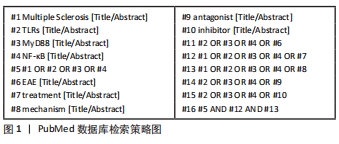[1] KUMAR V. Toll-like receptors in the pathogenesis of neuroinflammation. J Neuroimmunol. 2019;332:16-30.
[2] ZHENG C, CHEN J, CHU F, et al. Inflammatory role of TLR-MyD88 signaling in multiple sclerosis. Front Mol Neurosci. 2020;12:314.
[3] 赵佳莹,申艳佳,杨冉,等.多发性硬化药物研发中动物模型研究进展及应用[J].中国药理学通报,2022,38(6):801-806.
[4] 邹永杰,董哲. Toll样受体4在神经系统疾病中的研究进展[J].医学综述,2016,22(13):2516-2519.
[5] FERNANDEZ-PAREDES L, DE DIEGO RP, DE ANDRES C, et al. Close encounters of the first kind: innate sensors and multiple sclerosis. Mol Neurobiol. 2017; 54(1):101-114.
[6] 姜炅,董蕾,秦斌,等.Toll样受体7在人胃癌细胞株中的表达及其激动剂诱导SGC-7901细胞发生凋亡的实验研究[J].南方医科大学学报, 2014,34(11):1606-1610.
[7] 白自然,林倩,余雨迪,等.Toll样受体对T细胞功能及代谢的影响[J].生物化学与生物物理进展,2022,49(7):1218-1225.
[8] 郭鹏,张含,李长菲,等. Toll样受体通路调节Tregs功能的研究进展[J].生物工程学报,2020,36(9):1701-1712.
[9] 李依峣,鲁元,王旭,等. Toll样受体家族在神经炎症性疾病中的作用机制研究进展[J].中国新药杂志,2022,31(16):1602-1607.
[10] 李红梅,王显.TLR4/MyD88/NF-κB信号通路与动脉粥样硬化性心血管疾病的相关性研究进展[J].中国循证心血管医学杂志,2017,9(9):1132-1134.
[11] YUE Y, STONE S, LIN W. Role of nuclear factor κB in multiple sclerosis and experimental autoimmune encephalomyelitis. Neural Regen Res. 2018; 13(9):1507-1515.
[12] DING ZB, SONG LJ, WANG Q, et al. Astrocytes: a double-edged sword in neurodegenerative diseases. Neural Regen Res. 2021;16(9):1702-1710.
[13] 张振武,黄绍农,凌地洋,等.延胡索甲素调节NMDAR/NF-κB介导的信号通路对利血平诱导纤维肌痛大鼠的作用及机制研究[J].解放军医药杂志,2020,32(6):14-18.
[14] 杨宏鹏,张首国,曹莹,等.Toll样受体相关疾病研究进展[J].科学技术与工程,2022,22(35):15427-15435.
[15] 贾国泉,沈桂权,张权,等.Toll受体介导的MyD88/TRAF6/NF-κB研究[J].新发传染病电子杂志,2017,2(2):104-107, 111.
[16] LAWRENCE T. The nuclear factor NF-kappaB pathway in inflammation. Cold Spring Harb Perspect Biol. 2009;1(6):a001651.
[17] WASKO NJ, NICHOLS F, CLARK RB. Multiple sclerosis, the microbiome, TLR2, and the hygiene hypothesis. Autoimmun Rev. 2020;19(1):102430.
[18] ZEKKI H, FEINSTEIN DL, RIVEST S. The clinical course of experimental autoimmune encephalomyelitis is associated with a profound and sustained transcriptional activation of the genes encoding toll-like receptor 2 and CD14 in the mouse CNS. Brain Pathol. 2002;12(3):308-319.
[19] REYNOLDS JM, PAPPU BP, PENG J, et al. Toll-like receptor 2 signaling in CD4(+) T lymphocytes promotes T helper 17 responses and regulates the pathogenesis of autoimmune disease. Immunity. 2010;32(5):692-702.
[20] UMMENTHUN K, PEFEROEN LA, FINARDI A, et al. Pentraxin-3 is upregulated in the central nervous system during MS and EAE, but does not modulate experimental neurological disease. Eur J Immunol. 2016;46(3):701-711.
[21] HERRMANN I, KELLERT M, SCHMIDTH, et al. Streptococcus pneumoniae infection aggravates experimental autoimmune encephalomyelitis via toll-like receptor 2. Infect Immun. 2006;74(8):4841-4848.
[22] ABDIN AA, HASBY EA. Modulatory effect of celastrol on Th1/Th2 cytokines profile, TLR2 and CD3+ T-lymphocyte expression in a relapsing-remitting model of multiple sclerosis in rats . Eur J Pharmacol. 2014;742:102-112.
[23] 丁智斌,宋丽娟,王青,等.从动物模型的视角研究多发性硬化髓鞘保护和再生的小胶质细胞靶点[J].中国免疫学杂志,2022,38(6):753-757.
[25] DUPERRAY A, BARBE D, RAGUENEZ G, et al. Inflammatory response of endothelial cells to a human endogenous retrovirus associated with multiple sclerosis is mediated by TLR4. Int Immunol. 2015, 27(11):545-553.
[26] 马成东,胡全忠. Toll样受体4与神经系统疾病[J].世界最新医学信息文摘,2016,16(57):59-60,63.
[27] LEITNER GR, WENZEL TJ, MARSHALL N, et al. Targeting toll-like receptor 4 to modulate neuroinflammation in central nervous system disorders. Expert Opin Ther Targets. 2019;23(10):865-882.
[28] MCCARTHY GM, BRIDGES CR, BLEDNOW YA, et al. CNS cell-type localization and LPS response of TLR signaling pathways. F1000Res. 2017;6:1144.
[29] 刘欣,邵卫,陈国华.中医药靶向TLRs治疗中枢神经系统疾病研究进展[J].中医药学报,2022,50(3):108-113.
[30] 韩晶晶,张英,姚瑞芹,等.敲除toll样受体4基因对小鼠实验性自身免疫性脑脊髓炎的影响[J].神经解剖学杂志,2022,38(3):287-292.
[31] MARTA M, ANDERSSON A, ISAKSSON M, et al. Unexpected regulatory roles of TLR4 and TLR9 in experimental autoimmune encephalomyelitis. Eur J Immunol. 2008;38(2):565-575.
[32] MARTA M, MEIER UC, LOBELL A. Regulation of autoimmune encephalomyelitis by toll-like receptors. Autoimmun Rev. 2009;8(6):506-509.
[33] 张娟,尚德静.Toll 样受体 4(TLR4)信号通路及其靶向药物的研究进展[J].细胞与分子免疫学杂志,2021,37(7):657-662.
[34] 李易水,储心乔,彪雅宁,等.当归芍药散对非酒精性脂肪肝大鼠TLR4/MyD88/JNK信号通路的影响[J].中国实验方剂学杂志,2021,27(17):24-31.
[35] LIU Y, YIN H, ZHAO M, et al. TLR2 and TLR4 in autoimmune diseases: a comprehensive review. Clin Rev Allergy Immunol. 2014;47(2):136-147.
[36] PEINZ M, GARBE F, SCHMIDT H, et al. Innate immunity mediated by TLR9 modulates pathogenicity in an animal model of multiple sclerosis. J Clin Invest. 2006;116(2):456-464.
[37] KAWAI T, AKIRA S. TLR signaling. semin immunol. 2007;19(1):24-32.
[38] WEXLER AG, FRIELLE C, BERRY G, et al. The innate immune adaptor MyD88 is dispensable for spontaneous autoimmune demyelination in a mouse model of multiple sclerosis. J Neuroimmunol. 2013;255(1-2):60-69.
[39] ZHOU Y, CUI C, MA X, et al. Nuclear factor κB (NF-κB)-mediated inflammation in multiple sclerosis. Front Immunol. 2020;11:391.
[40] RINNE M, MATLIK K, AHONEN T, et al. Mitoxantrone, pixantrone and mitoxantrone (2-hydroxyethyl)piperazine are toll-like receptor 4 antagonists, inhibit NF-κB activation, and decrease TNF-alpha secretion in primary microglia. Eur J Pharm Sci. 2020;154:105493.
[41] LI B, BAYLINK DJ, DEB C, et al. 1,25-Dihydroxyvitamin D3 suppresses TLR8 expression and TLR8-mediated inflammatory responses in monocytes in vitro and experimental autoimmune encephalomyelitis in vivo. PLoS One. 2013;8(3):e58808.
[42] GAMBUZZA M, LICATA N, PALELLA E, et al. Targeting toll-like receptors: emerging therapeutics for multiple sclerosis management. J Neuroimmunol. 2011;239(1-2):1-12.
[43] CHURCH JS, MILICH LM, LERCH JK, et al. E6020, a synthetic TLR4 agonist, accelerates myelin debris clearance, schwann cell infiltration, and remyelination in the rat spinal cord. Glia. 2017;65(6):883-899.
[44] GOOSHE M, ALEYASIN AR, ABDOLGHAFFARI AH, et al. Toll like receptors: a new hope on the horizon to treat multiple sclerosis. Expert Rev Clin Immunol. 2014;10(10):1277-1279.
[45] DISHON S, SCHUMACHER A, FANOUS J, et al. Development of a novel backbone cyclic peptide inhibitor of the innate immune TLR/IL1R signaling protein MyD88. Sci Rep. 2018;8(1):9476.
[46] KIELIAN T, Dew PD. Effects of peroxisome proliferator-activated receptor-gamma agonists on central nervous system inflammation. J Neurosci Res. 2003;71(3):315-325.
[47] CURRAN NM, GRIFFIN BD, O’TOOLE D, et al. The synthetic cannabinoid R(+)WIN 55, 212-2 inhibits the interleukin-1 signaling pathway in human astrocytes in a cannabinoid receptor-independent manner. J Biol Chem. 2005;280(43):35797-35806.
[48] MCGUIRE VA, RUIZ-ZORRILLA DIEZ T, EMMERICH CH, et al. Dimethyl fumarate blocks pro-inflammatory cytokine production via inhibition of TLR induced M1 and K63 ubiquitin chain formation. Sci Rep. 2016;6:31159.
[49] ZHANG L, LU X, GONG L, et al. Tetramethylpyrazine protects blood-spinal cord barrier integrity by modulating microglia polarization through activation of STAT3/SOCS3 and inhibition of NF-кB signaling pathways in experimental autoimmune encephalomyelitis mice. Cell Mol Neurobiol. 2021;41(4):717-731.
[50] MENG G, RUTZ M, SCHIEMANN M, et al. Antagonistic antibody prevents toll-like receptor 2-driven lethal shock-like syndromes. J Clin Invest. 2004; 113(10):1473-1481.
[51] SUAREZ-FARINAS M, ARBIET R, JIANG W, et al. Suppression of molecular inflammatory pathways by Toll-like receptor 7, 8, and 9 antagonists in a model of IL-23-induced skin inflammation. PLoS One. 2013;8(12):e84634.
[52] 张慧宇,郭敏芳,于婧文,等.法舒地尔(Fasudil)抑制脂多糖诱导的小鼠星形胶质细胞活化和炎性反应及其机制[J].细胞与分子免疫学杂志, 2018,34(6):505-510.
[53] 侯绍蔚,刘岳婷,郭敏芳,等.盐酸法舒地尔治疗实验性自身免疫性脑脊髓炎的潜能与抗炎作用[J].中国临床神经科学,2012,20(2):126-134.
[54] 于婧文,李艳花,张海飞,等.新型Rho激酶抑制剂FSD-C11对EAE的免疫调节作用[J].免疫学杂志,2016,32(8):651-655.
[55] HE Y, AN J, YIN JJ, et al. Ethyl pyruvate enhances spontaneous remyelination by targeting microglia phagocytosis. Int Immunopharmacol. 2019;77: 105929.
[56] MILJKOVIC D, BLAZEVSKI J, PETKOVIC F, et al. A comparative analysis of multiple sclerosis-relevant anti-inflammatory properties of ethyl pyruvate and dimethyl fumarate. J Immunol. 2015;194(6):2493-2503.
[57] 韩庆贤,丁智斌,李晓慧,等.基于抑制小胶质细胞介导的炎症反应探讨淫羊藿总黄酮保护髓鞘的机制[J].中华中医药杂志,2022,37(3):1357-1361.
[58] 刘建春,张红珍,郭文娟,等.黄芪甲苷对实验性自身免疫性脑脊髓炎小鼠的防治作用[J].中华中医药杂志,2020,35(6):3119-3122.
[59] 杨春彦.补阳还五汤对实验性自身免疫性脑脊髓炎的神经保护和免疫调节作用研究[D].太原:山西中医学院,2016.
[60] 王晓庆,田倩倩,李艳花,等.补阳还五汤对EAE小鼠免疫调节的作用[J].中国免疫学杂志,2017,33(1):52-57.
[61] 关东升,高颖,娄丽霞,等. 益肾达络饮对实验性自身免疫性脑脊髓炎NF-κB信号传导通路的影响[J].中国中医基础医学杂志,2012,18(7):732-735.
|






